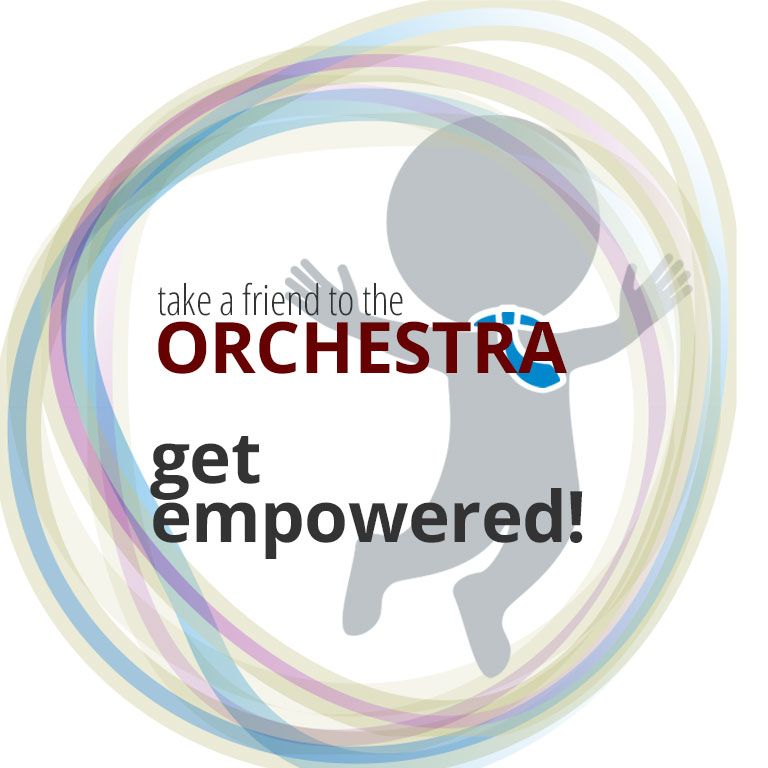I consider myself fortunate to come across individuals like Frank Manheim during my lifetime. Frank is the benchmark for a “knowledgeable nonprofessional classical music activist”. His passion for the art moves him well beyond pontification into that realm of activism.
His personal research and effort into a variety of endeavors to benefit classical music in a number of mediums are simply too numerous to mention. Frank’s contribution recounts a lifetime of personal experience and is filled with so much good material you’ll need to read it through a few times just to absorb everything.
“Taking friends to a concert” can be a metaphor for the task of revitalizing classical music in
America. I make no apologies for being an end-member proponent of
audience empowerment, I disagree with recent writers who variously
opine that classical music is moribund, or was only superficially
connected with the U.S. in the first place (Joseph Horowitz). It has
indeed declined – but McManus’ initiative is an example of emerging
movements that have the potential to revive it.
I was fortunate to grow up at a time when classical music was an integral
part of America – where even the restored 19th Century mining town of
Central City, Colorado, had its Opera House, and Count Basie had a
long-running radio music show entitled, lovingly, “The Chamber Music
Society of Lower Basin Street”. As an end-member proponent for audience
empowerment, I find the anthology idea pertinent and fascinating. I’ll
look forward to other contributions.
First, let me introduce my discussion with a sampling of concerts whose attractions caused me
and my wife to take the initiative in inviting friends to join us.
Then, let’s take up the subject of “attractions” a little more
systematically. We’ll look at strategies of the Board of the Falmouth
Music Association, the oldest music performance society on Cape Cod,
MA, while I was Program Chairman of the FMA from 1979-1983.
Kennedy Center opera: I have not attended many live opera performances in my
life – though all that I did were memorable. But since I arrived here
in the Washington D.C. area (1999), it became clear to me that it was
mandatory to take advantage of the high quality and imaginative
programming by Placido Domingo – supported by the highly capable
Kennedy Hall director, Michael Kaiser. This team has elevated opera to
a high level of interest in a sophisticated public – and has ticket
prices up to $200 to prove it. We decided to make it known through
our local church bulletin that we wanted to share an advance series
ticket block to opera selections. That way we could get affordable
seats whereas these might already be sold out by the time
single-concert tickets were opened to the public. We found takers –
and made some good friends in the process.
One of Domingo’s hallmarks is to always include unusual, attractive operas each season.
Thus, we have been attending such rare spectacles as Handel’s Julius
Caesar, Massenet’s Le Cid (first U.S. production in 100 years), and
Tchaikovsky’s Queen of Spades. In some cases, the people we invited had
never attended opera. In this case I lent them an opera book so that
familiarity with the plot and characters would heighten engagement.
When we attended the same event, we arranged to have dinner at Kennedy
Center’s fine buffet restaurant in order to “talk music”, warm up, and
make the most of the occasion. The idea is, of course, to make concert
going a celebratory and fun event on several levels.
Telemann: Day of Judgment (Der Tag des Gerichts): I am a fan of baroque composer,
Georg Philipp Telemann, not least because among all composers in
history, he was probably the most committed to performers and
listeners. He and J.S. Bach held each other in high mutual regard (he
served as Godfather to Bach’s son, Carl Philipp Emmanuel), but took
different musical approaches. Bach, in following his muse, could
neglect singability or effect on his audiences in a number of his
choral works (e.g. the “sublimely ugly” St. John’s Passion). Because of
Bach’s profundity and uncompromising mastery of seamless counterpoint,
our musical establishment leaders have singled him out as THE baroque
composer. Telemann – though the unquestioned leader among German
composers of his time, has been relegated to footnotes.
Unlike Bach, Telemann normally rejected strict structural counterpoint,
preferring to innovate with decorative counterpoint and harmonic
effects. He played every instrument of the then orchestra in order to
be able to exploit its timbres to maximum effectiveness. Telemann
openly sought to bring enjoyment to players of all levels of skill, and
prided himself for placing musically interesting material in the
continuo part of trio sonatas, and the orchestral component of
concerti. Through continuing research of the 50-year old Telemann
Archiv new editions of hitherto unknown Telemann masterpieces continue
to roll out.
When one of Telemann’s late (and still relatively little-known) choral-orchestral masterpieces was to be
presented under the aegis of the International Institute for Culture in
Baltimore (2000) I knew we couldn’t miss it. We invited a USGS
hydrologist who plays violin in the Fairfax County Symphony, his wife
and family. During our preliminary dinner in Baltimore (combining food
and conviviality with music is no-fail) I talked about why I liked
Telemann, including the fact that Telemann was a modern-leaning
democrat in philosophy. He eschewed the courts that chased him in favor
of working in independent cities (Frankfurt and Hamburg), where he
could serve the public free of the whims of royalty. Our friends were
musically literate but rarely attended concerts. Their knowledge of
classical music was largely limited to “standards”.
In sum, the performance, led by Thomas Hetrick, was superb and a powerful
experience for all of us. However, a significant part of the obvious
enjoyment of our friends was the novelty and surprise elements in the
evening. Getting to know Telemann better helps explain why, after being
relegated to footnote status, classical radio stations like WGMS and
WBJC that cater to more general audiences now tend to play more
Telemann than Bach. In contrast, WNET, which maintained a more
academically correct repertory, overwhelmingly favored Bach – but has
now dropped classical music altogether.
The Falmouth Music Association grows its audience
As chairman of the Program committee I had a good-sized, music-loving
board to assist in operating a 4-performance winter music season of
professional soloists with accompaniment, or chamber groups. The choice
of groups was predicated on the usual criteria that would appeal to the
maximum number of a diverse audience. Proposed programs were reviewed
by all 15 members of the board, most of whom were called on to help
with practical tasks – advertising, program & ticket printing,
stage management, refreshments, etc. The “popular market” test of
program choices helped assure that idiosyncratic personal tastes didn’t
dominate the repertory.
We undertook serious audience research: with the aid of an engineer at the Woods Hole Oceanographic
Institution, we conducted a poll of a randomized selection of the
entire community of 28,000 persons, chosen from the telephone book.
From that poll we learned the musical tastes of the community, ranging
from pop (rock) through country, and folk, to classical in various
subcategories (20% of the half of the polled population that had
serious interest in music “liked classical”).
Next, we initiated “Local Artists Concerts”, which combined local professional
musical talent and skilled amateurs in carefully prepared theme
concerts. This was truly a fine learning experience. I came to
understand that professional impresarios don’t guess how many people
are going to come to their concerts. They program and plan to achieve a
requisite audience size. We cultivated the musical resources and
interests of the community. One year we put on a sellout Evening of
Cape Verdean Music, featuring a band known to the Cape Verdean
population (Portuguese-African) of southeastern Massachusetts. Half the
evening was concert – the rest dance – at the Cape Verdean Club.
Knowing the interest in early Americana in a town incorporated in 1686, we
acquired microfilms of the entire Thomas Jefferson Monticello music
collection (Jefferson was an accomplished violinist and avid music
lover) from the rare book archive at the University of Virginia in
Charlottesville,. We then staged a “Music of the Time of Thomas
Jefferson” concert – including composers enjoyed by Jefferson but now
forgotten, like Balbastre and Schobert. No music-loving person could
pass up novelty features like this rare opportunity, or an
“Austro-Hungarian” evening, the hall festooned with appropriate flags.
The families and circle of friends of locally-based professionals and
skilled amateurs contributed their numbers to the audience. With
performers donating services, these moneymakers increased the funding
available to hire professional groups. Children under 12 always came
free to FMA concerts – encouraging families to attend, and providing
exposure to music for young people.
A popular feature that I now long for in vain in the concerts I now attend in the Northern
Virginia -DC area was the longstanding tradition of getting to meet
performers after the concert at an open reception with refreshments:
cookies and punch, etc. The musicians enjoyed them too. Many
professionals admitting to feeling a let down when they simply packed
up instruments and went to their hotel after making beautiful music. At
these receptions we learned, for example, how the distinguished
contrabass virtuoso, Gary Karr, had acquired his magnificent Amati
bass (over 300 years old). It was GIVEN to him – to his utter surprise
– at a special party after his Carnegie Hall debut by the widow of the
famed Russian-American conductor of the Boston Symphony, Serge
Koussevitzky. Koussevitzky had been a virtuoso bass player in his
native Russia, before he became a conductor and came to the U.S. Again,
breaking down the wall between musicians and audience was a win-win
proposition for both.
In short, we learned that the keys to filling concert halls began with providing quality classical music but
by no means ended there. It was essential to provide novel and
interesting experiences for the audience in question in a human and
convivial environment. And the potential for the experience had to be
conveyed through intensive and preferably enticing advertising. We spun
coming concert events (especially the Local Artists Concerts) into
interesting features that we could place in the local paper without
paying for advertising. We prepared posters on 11×17 colored card stock
that could be printed from computer format on Xerox machines – almost
trivial in cost, but highly effective. In short, creativity substituted
for expensive services wherever possible.
I emphasize that much of what I myself enjoy in music and what, in my experience,
attracts audiences, is not necessarily classical masterpieces certified
by the professional establishment (which I revere for its knowledge
and skills). Rather it is music selected and performed for the
edification of audiences as special or novel events – perhaps unlikely
to be heard again. Success in achieving this goal means knowing the
audience and making sure it gets the message about a proposed event. In
a sense, musical programming, done right, is as creative a process as
playing music.


